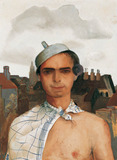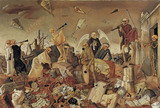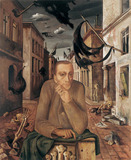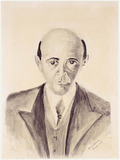Felix Nussbaum: Selbstbildnis mit Maske und Schalltrichter [ Self-Portrait with Mask and Paper Horn], painting (ca. 1936)
Felix Nussbaum: Selbstbildnis mit Maske und Schalltrichter [ Self-Portrait with Mask and Paper Horn], painting (ca. 1936)
During his years of exile, masks took on a central role in the self-portraits of the painter Felix Nussbaum. Even before, Nussbaum had used masks as a metaphor to give expression to the two-faced character of reality. In exile, however, the mask metaphor took on additional facets. In the design of his mask motifs, Nussbaum was presumably influenced by the symbolic painter James Ensor, whom Nussbaum met in Ostende, Belgium, shortly before he fled; the two painters had probably met for the first time in 1935. Ensor showed Nussbaum his collection of masks and explained to him the mask motifs in his pictures. In Ensor's paintings, masks stand for the vanity of existence and the absurdity of the world, topics which gained in currency for Nussbaum during his exile.
For the Jewish artist who had fled to Belgium from Nazi persecution, masks became primarily a symbol of the strategies of concealment and disguise that were now crucial to his survival. In Selbstbildnis mit Maske und Schalltrichter the masked subject wears a blue paper hat, a “Napoleon hat”, adorned with green leaves. One hand in a green, long glove holds a horn made of paper. Paper horns are a recurring motif in Nussbaum's later works. In his militaristic-looking costume, Nussbaum seems to be sounding the attack. Through the mask which conceals the face, however, the appeal is revealed to be an empty pose and purely internal defiance.
The mask motif is also found in the works of other exiled painters such as Max Beckmann or Paul Klee.






